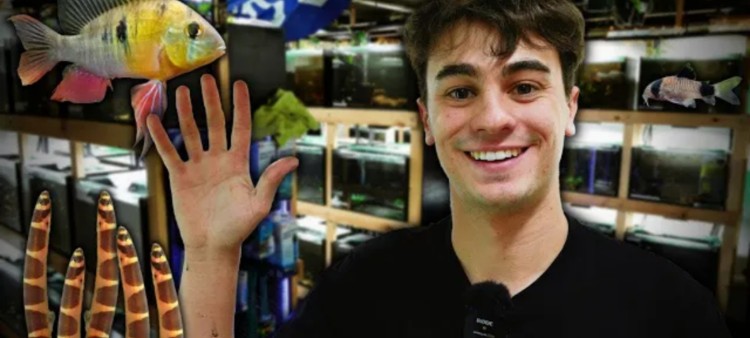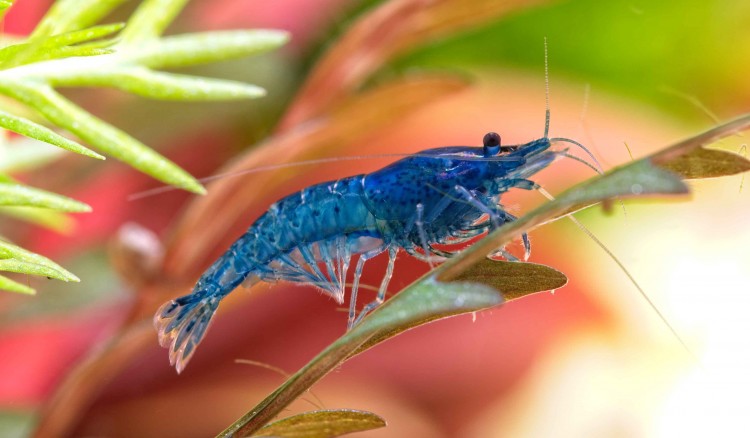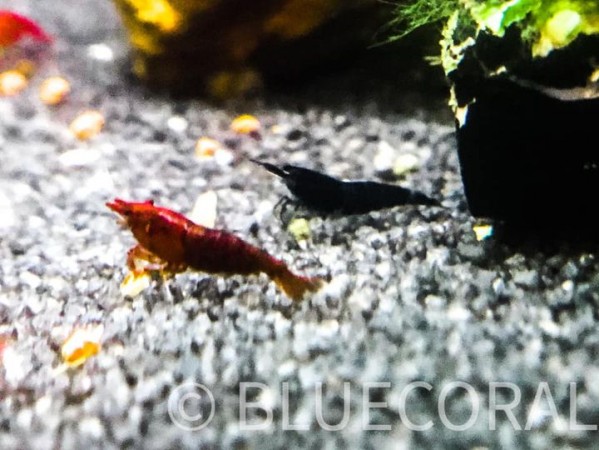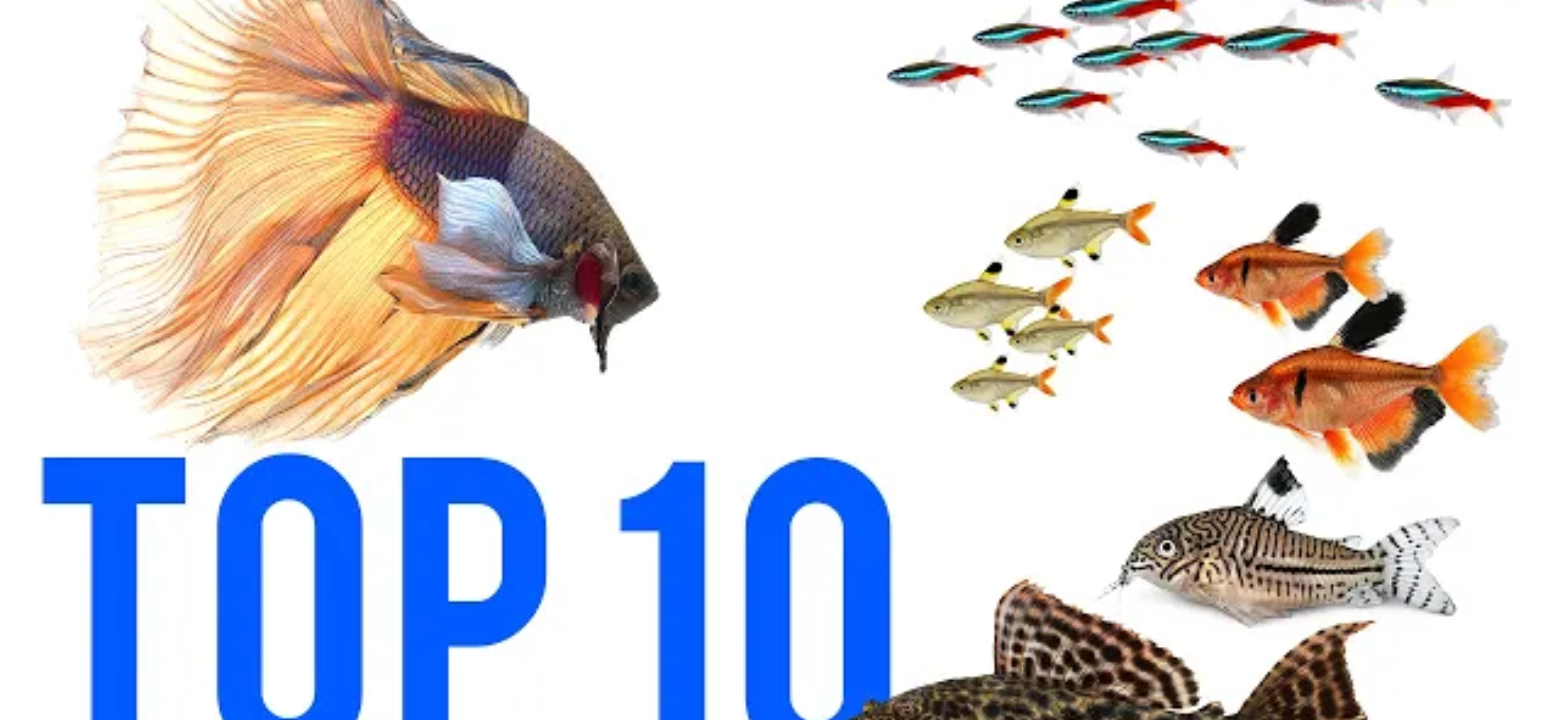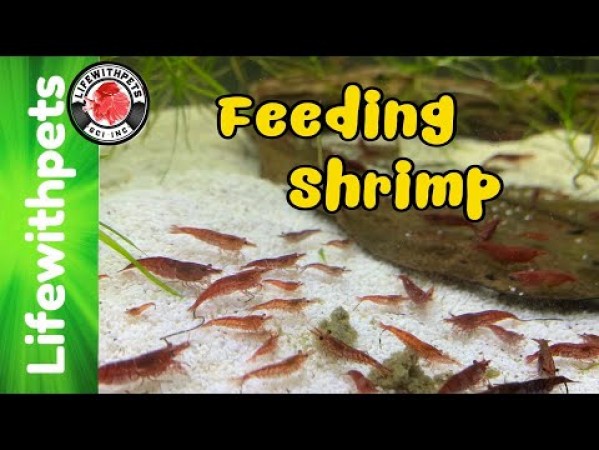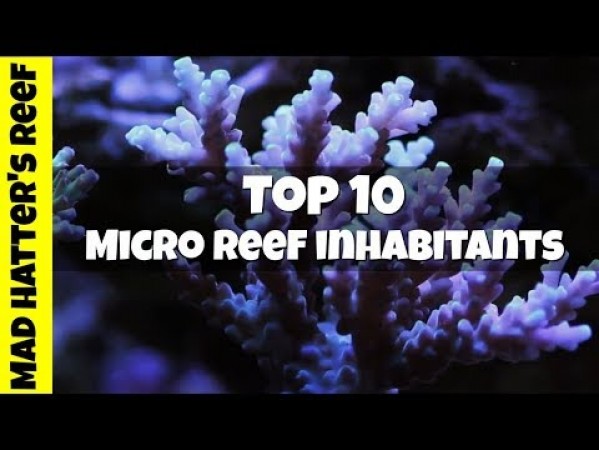- Name:
Banded Coral Shrimp
(View AKA's) - Family: Stenopodidea
- Species: Shrimp
- Scientific Name: Stenopus hispidus
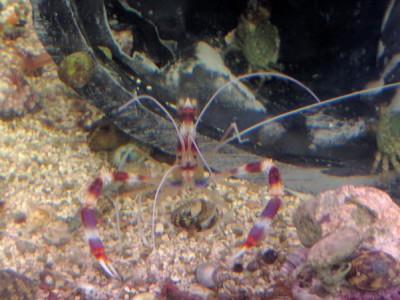

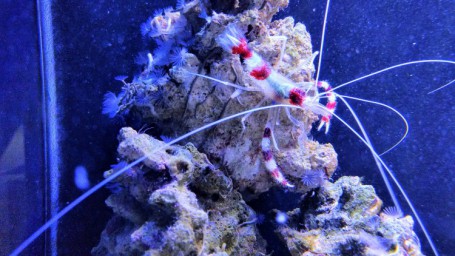
General info about Banded Coral Shrimp
The Banded Coral Shrimp, also known as the Banded Cleaner Shrimp, is a well-known inhabitant of tropical coral reefs. The coral banded shrimp is a shrimp-like decapod, but not a true shrimp. It is a member of the family, Stenopodidae and the genus, Stenopus. The scientific name of this decapod crustacean is Stenopus hispidus. It is also known as banded coral shrimp, banded prawn, banded boxer shrimp, and barber-pole shrimp.
The Banded Coral Shrimp is an attractive addition to aquariums because of its colorful body and unique shape. The base color is transparent whereas the carapace, abdomen and the large third pereiopod are all banded red and white. The very long antennae and other pereiopods are white. The abdomen, carapace and third pereiopods are covered in small spines. It has long pincers and antennae. At the head, there are four, white antennae of which two are forked. The antennae are twice as long as the body. In the home aquarium, provide sufficient room for the Banded Coral Shrimp so it can move about freely without its long antennae touching neighboring corals or anemones. The Banded Coral Shrimp are usually found in pairs hiding in crevices and small caves on the reef.
The body surface is covered with short spines, which are used in defense. The first three pairs of legs have forceps, the third pair being significantly larger but the others are mainly used for cleaning fish. That's why members of the Stenopodidae family are known as "Boxing Shrimp" because of the large pincers on their third set of legs. These pinchers are often held erect and give the Banded Coral Shrimp the appearance of a boxer ready to fight. Though the Banded Coral Shrimp can be aggressive towards other Banded Coral Shrimp and smaller shrimp of different species, most are peaceful towards fish, corals, and invertebrates within your aquarium. Because of its aggressive disposition towards other Banded Coral Shrimp, the Banded Coral Shrimp should be housed individually or kept as a true mated pair.
Two things you might not know about this little creature is that first of all, it is very faithful. A trait mostly associated with mammals and some birds, this little crustacean also chooses its mate to pair for a lifetime. Only a mated pair may be kept in one tank and these form a monogamous relationship. If you are not certain that the pair is indeed a mated pair, it is best not to take the risk as they’re very territorial and being as small as they are, this means that their territories can’t be that big but they defend an area of one to two meters in diameter against other crustaceans and in particular other Coral Banded Shrimps. If another Coral Banded Shrimp enters its territory, it will defend it, with one or the other shrimp losing legs and pincers in the battle that will follow. The Coral Banded Shrimp will regrow lost legs during its next molt. While molting, the Banded Coral Shrimp will often hide from sight for 1-2 days in the rocks of the reef.
The Banded Coral Shrimp is a non-obligate cleaner shrimp of larger fishes and therefore waits - upside down - for customers swimming by. To signal is willing to clean it performs a dance shaking its white antennae and banded body. This attracts fish that, in turn, start flashing their colors to signal to the shrimp that they need cleaning. The fish moves in close enough for the shrimp to reach or when the fish is big enough, it simply just ‘jumps’ on using their swimmerets, after which it starts removing parasites, fungi and damaged tissue using its three pairs of claws.
The Banded Coral Shrimp is relatively hardy and boasts an aquarium-suited length that rarely exceeds 3 inches, 6 inches with the antennae. They are most often found in areas with lots of fish traffic, such as on prominent outcrops and large caves or overhangs. The adult Banded Coral Shrimp does not seem to have any natural predators. The symbiosis between the shrimp and the reef community is highly developed to a point where the shrimp can safely enter the mouth and gills of a fish without being eaten. In an experimental setup, a Banded Coral Shrimp was even placed in a tank with an octopus, which is known to eat crustaceans on a regular basis. Even though the octopus was not being fed during the experiment, the shrimp was not eaten for several weeks, until the moment the octopus apparently got too hungry.
It rests by day and becomes active at dusk. In the wild, the Coral Banded Shrimp is nocturnal, hiding under ledges and in caves during the day and feeding at night. In an aquarium, they do best if they have a place to hide during the day. Strong flips of its tail will help the Banded Coral Shrimp to escape in case of danger although no natural predatory enemies are known. The deepest it has ever been found is at the depth of 600 feet, but since the fish that it cleans to gather its food are most abundant in the shallow reefs, it is commonly found just below the low tide line, in waters between 6 to 12 feet deep.
Shrimps in general and Coral Banded Shrimps, in particular, are very sensitive to shifts in water chemistry, with drastic changes in pH being a prime killer when putting a shrimp into an aquarium. For this reason, take your time when acclimating shrimps. The pH of the water should be in the range of 8 to 8.4. The ideal temperature is 72 to 80°F. The minimum tank size should be about 30 gallons so that it gets enough space to move around freely.
It can be kept with aquarium fish, corals, and other invertebrates. But it can pinch the corals and anemones, and steal their food, for which many do not consider it a very good choice for reef aquariums.it can also attack other members of the same species, along with small shrimp, worms, and other crustaceans like snails, corals, and hermit crabs. Do not keep it along with lionfish, eels, snappers, and triggers. These fish are large and they can eat up the small banded coral shrimp.
Banded Coral Shrimp Diet & Nutrition
Coral Banded Shrimp is a scavenger by nature and will take most meaty foods. It may also feed on small fishes, other crustaceans, snails and worms. Banded coral shrimp are usually nocturnal feeders, rests by day and becomes active at dusk. They wave their long white antennae around and exhibit a dancing swaying movement. This to attract client fish to clean. They will readily devour Polychaete Worms when they are present. The ideal method of feeding is to place the food in front of it with the help of a feeding stick. In the wild, this shrimp will feed on algae, detritus, and carrion as well as parasites which it picks from fish.
In areas where many fish congregate they may be found in the company of the standard cleaner shrimp. Usually, a fish approaches a banded coral shrimp and allows the shrimp to begin removing the parasites from him. It uses its large chelipeds and three sets of smaller claws called maxillipeds to scrape and pick off food and parasites from the fish hosts body, mouth, and gills or wherever needed. Sometimes food is shared among mated partners.
Determining Sex of Banded Coral Shrimp
The male is smaller and more slender. The female can also be recognized by the presence of greenish ovaries visible through the transparent carapace.
Breeding & Spawning Banded Coral Shrimp
The species lives in monogamy. The banded coral shrimp usually do not breed in captivity and even if they do, either the other members of the aquarium consume the larvae, or the larvae get sucked in by the filter. Even though it is hard to breed this species, this is the way to do it; the female can only mate at a certain stage of molting which is called ecdysis. During mating, the male will first display a courtship dance in front of the female. The male then transfers a sperm sack to the freshly molted female which soon will inseminate the eggs and stick them to the abdominal legs. The young hatch after 16 days. The hatchlings will be attached to their mother for about six weeks before they detach, float to the surface of the water and become part of the plankton and drifting in the ocean currents. After some weeks and several molts, the young descend from the plankton and settle to the bottom and find a dark place to hide. The Coral Banded Shrimp may live 2-3 years, sometimes longer.
Banded Coral Shrimp Origin
It is found in the Western Atlantic from Brazil all the way up to Canada, throughout the entire Caribbean region and even around Australia and New Zealand.
Caution with Banded Coral Shrimp
Like other invertebrates, the Banded Coral Shrimp is intolerant of high nitrate or copper levels. Be sure to maintain proper iodine levels in the aquarium to help ensure proper molting. The Banded Coral Shrimp must be acclimated slowly to avoid any salinity and/or pH shock.
Acclimating Banded Coral Shrimp
Original Detail
| Name | Species | Family | Scientific Name | More Detail | Added by |
|---|---|---|---|---|---|
| Banded Coral Shrimp | Shrimp | Stenopodidea | Stenopus hispidus | The Banded Coral Shrimp, also known as the Banded Cleaner Shrimp, is a well-known inhabitant of tropical coral reefs. The coral banded shrimp is a shrimp-like decapod, but not a true shrimp. It is a member of the family, Stenopodidae and the genus, Stenopus. The scientific name of this decapod crustacean is Stenopus hispidus. It is also known as banded coral shrimp, banded prawn, banded boxer shrimp, and barber-pole shrimp. The Banded Coral Shrimp is an attractive addition to aquariums because of its colorful body and unique shape. The base color is transparent whereas the carapace, abdomen and the large third pereiopod are all banded red and white. The very long antennae and other pereiopods are white. The abdomen, carapace and third pereiopods are covered in small spines. It has long pincers and antennae. At the head, there are four, white antennae of which two are forked. The antennae are twice as long as the body. In the home aquarium, provide sufficient room for the Banded Coral Shrimp so it can move about freely without its long antennae touching neighboring corals or anemones. The Banded Coral Shrimp are usually found in pairs hiding in crevices and small caves on the reef. The body surface is covered with short spines, which are used in defense. The first three pairs of legs have forceps, the third pair being significantly larger but the others are mainly used for cleaning fish. That's why members of the Stenopodidae family are known as "Boxing Shrimp" because of the large pincers on their third set of legs. These pinchers are often held erect and give the Banded Coral Shrimp the appearance of a boxer ready to fight. Though the Banded Coral Shrimp can be aggressive towards other Banded Coral Shrimp and smaller shrimp of different species, most are peaceful towards fish, corals, and invertebrates within your aquarium. Because of its aggressive disposition towards other Banded Coral Shrimp, the Banded Coral Shrimp should be housed individually or kept as a true mated pair. Two things you might not know about this little creature is that first of all, it is very faithful. A trait mostly associated with mammals and some birds, this little crustacean also chooses its mate to pair for a lifetime. Only a mated pair may be kept in one tank and these form a monogamous relationship. If you are not certain that the pair is indeed a mated pair, it is best not to take the risk as they’re very territorial and being as small as they are, this means that their territories can’t be that big but they defend an area of one to two meters in diameter against other crustaceans and in particular other Coral Banded Shrimps. If another Coral Banded Shrimp enters its territory, it will defend it, with one or the other shrimp losing legs and pincers in the battle that will follow. The Coral Banded Shrimp will regrow lost legs during its next molt. While molting, the Banded Coral Shrimp will often hide from sight for 1-2 days in the rocks of the reef. The Banded Coral Shrimp is a non-obligate cleaner shrimp of larger fishes and therefore waits - upside down - for customers swimming by. To signal is willing to clean it performs a dance shaking its white antennae and banded body. This attracts fish that, in turn, start flashing their colors to signal to the shrimp that they need cleaning. The fish moves in close enough for the shrimp to reach or when the fish is big enough, it simply just ‘jumps’ on using their swimmerets, after which it starts removing parasites, fungi and damaged tissue using its three pairs of claws. The Banded Coral Shrimp is relatively hardy and boasts an aquarium-suited length that rarely exceeds 3 inches, 6 inches with the antennae. They are most often found in areas with lots of fish traffic, such as on prominent outcrops and large caves or overhangs. The adult Banded Coral Shrimp does not seem to have any natural predators. The symbiosis between the shrimp and the reef community is highly developed to a point where the shrimp can safely enter the mouth and gills of a fish without being eaten. In an experimental setup, a Banded Coral Shrimp was even placed in a tank with an octopus, which is known to eat crustaceans on a regular basis. Even though the octopus was not being fed during the experiment, the shrimp was not eaten for several weeks, until the moment the octopus apparently got too hungry. It rests by day and becomes active at dusk. In the wild, the Coral Banded Shrimp is nocturnal, hiding under ledges and in caves during the day and feeding at night. In an aquarium, they do best if they have a place to hide during the day. Strong flips of its tail will help the Banded Coral Shrimp to escape in case of danger although no natural predatory enemies are known. The deepest it has ever been found is at the depth of 600 feet, but since the fish that it cleans to gather its food are most abundant in the shallow reefs, it is commonly found just below the low tide line, in waters between 6 to 12 feet deep. Shrimps in general and Coral Banded Shrimps, in particular, are very sensitive to shifts in water chemistry, with drastic changes in pH being a prime killer when putting a shrimp into an aquarium. For this reason, take your time when acclimating shrimps. The pH of the water should be in the range of 8 to 8.4. The ideal temperature is 72 to 80°F. The minimum tank size should be about 30 gallons so that it gets enough space to move around freely. It can be kept with aquarium fish, corals, and other invertebrates. But it can pinch the corals and anemones, and steal their food, for which many do not consider it a very good choice for reef aquariums.it can also attack other members of the same species, along with small shrimp, worms, and other crustaceans like snails, corals, and hermit crabs. Do not keep it along with lionfish, eels, snappers, and triggers. These fish are large and they can eat up the small banded coral shrimp.
|
PalaciosAn |
Changed by users
| Submitted Date | Submitted By | Status | Action |
|---|---|---|---|
| 2019-01-22 20:16:20 | merve kutsal | Approved | Edit |
| 2019-01-22 19:36:18 | merve kutsal | Approved | Edit |
| 2019-01-22 19:28:14 | merve kutsal | Approved | Edit |
| 2019-01-22 19:17:02 | merve kutsal | Approved | Edit |
| 2019-01-22 19:06:29 | merve kutsal | Approved | Edit |
| 2019-01-22 18:45:35 | merve kutsal | Approved | Edit |
| 2019-01-22 17:30:38 | merve kutsal | Approved | Edit |
| 2019-01-22 17:04:38 | merve kutsal | Approved | Edit |
| 2019-01-22 16:45:10 | merve kutsal | Approved | Edit |
| 2019-01-07 15:40:19 | Mariene Lescano | Approved | Edit |


